As an Amazon Associate KitchenwareSets.com earns from qualifying purchases.
Genius Aesthetic Apartment Kitchen Ideas For Your Rental
Struggling to love a kitchen that isn’t yours? It’s a classic renter’s dilemma.
You’re dealing with a small kitchen that has dated countertops, boring cabinets, and landlord rules that forbid permanent changes. This guide is for creating an aesthetic apartment kitchen, a space that is both beautiful and functional, using only non-permanent, damage-free solutions. You want a kitchen that feels like home, not just a temporary stop.
The best way to create an aesthetic apartment kitchen is by focusing on reversible changes. This guide will show you how to use removable products, maximize vertical storage to declutter counters, and upgrade lighting with simple, budget-friendly ideas that won’t risk your security deposit.
Feeling Stuck With a Dated, Drab Rental Kitchen?
That feeling of walking into your rental kitchen and just… sighing. We’ve all been there. You’re faced with ugly countertops from a bygone decade, bland builder-grade cabinets, and flooring you’d never choose yourself. Worse yet, you’re bound by a lease that strictly prohibits painting, drilling, or making any real changes. It can feel incredibly frustrating, leaving you uninspired in one of the most important rooms in your home.
But what if you could completely transform the look and feel of your space without picking up a paintbrush or risking your security deposit? It’s entirely possible. The secret lies in focusing on clever, non-permanent, and renter-friendly solutions. These are the tried-and-tested temporary kitchen updates that make a huge impact, from covering dated surfaces with stylish vinyl film to adding smart storage that gets everything off your limited counters. This guide is your collection of genius ideas to create a kitchen you’ll absolutely love spending time in.
9 Genius Aesthetic Apartment Kitchen Ideas (That Won’t Risk Your Deposit)
Ready to turn your drab rental kitchen into a stylish, functional space? This list covers everything from major surface makeovers that look like a renovation to small decorative touches that take less than an hour. Each of these aesthetic apartment kitchen ideas is designed with renters in mind, meaning they are budget-friendly, easy to implement, and—most importantly—100% reversible. Let’s dive into the simple DIY projects that will make you fall in love with your kitchen.
1. Cover Dated Countertops with Removable Contact Paper
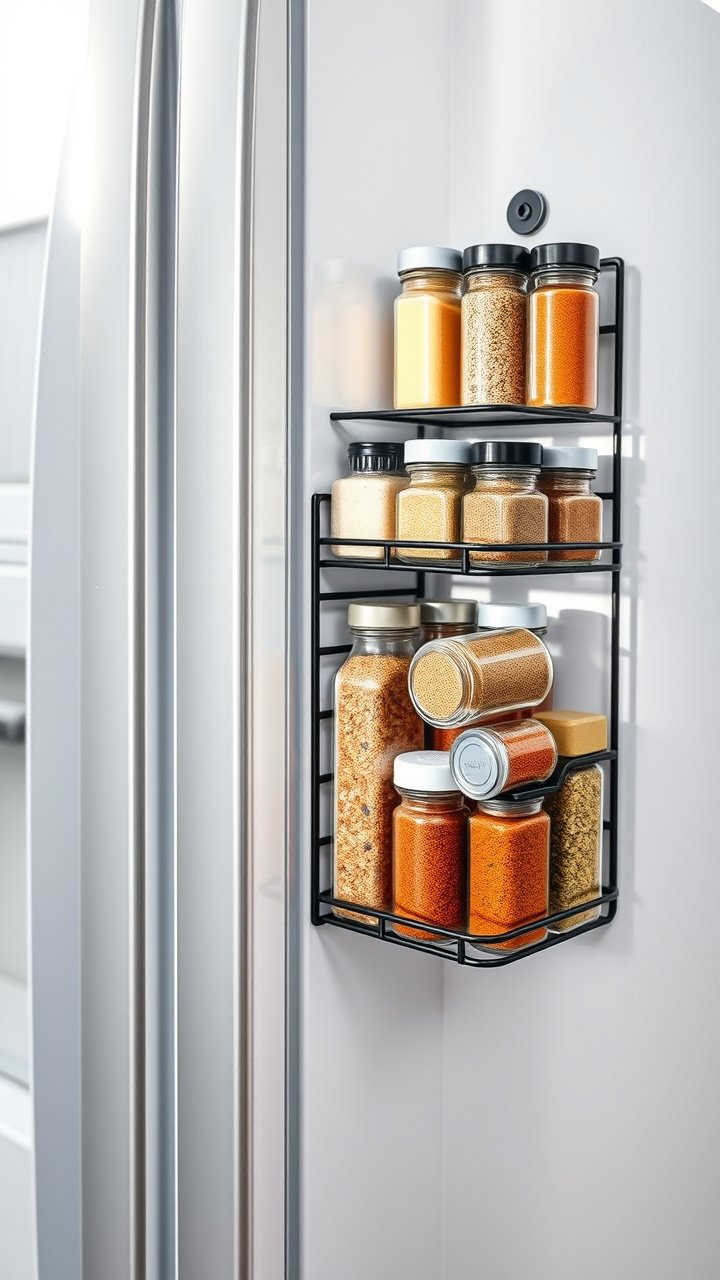
Pin this genius countertop tips to your ‘Kitchen Makeover’ board!
Dated laminate countertops are one of the biggest challenges in a rental kitchen. High-quality, waterproof vinyl contact paper is a game-changing renter-friendly countertop solution that can mimic the look of expensive materials like marble or butcher block for a tiny fraction of the cost.
Materials Needed:
- High-quality, waterproof vinyl contact paper (measure for 6+ inches of overhang on all sides)
- Application kit with a felt-edge squeegee and a sharp craft knife
- Measuring tape
- Degreasing cleaner (like TSP substitute) and cloths
- Hairdryer (optional, for stretching around corners)
Step-by-Step Directions:
- Prep the Surface: Thoroughly clean your countertops with the degreasing cleaner to remove any grease or grime. A clean surface is critical for adhesion. Let it dry completely.
- Measure and Cut: Roll out the contact paper and measure a piece that is large enough to cover your counter section, including several inches of overhang for the front, sides, and backsplash.
- Apply Slowly: Peel back only a few inches of the paper backing. Align the edge of the paper with the back of your countertop and press it down.
- Smooth and Squeegee: Working from the center out, use the squeegee to smooth the paper onto the surface. Continue peeling the backing a few inches at a time while smoothing to prevent air bubbles.
- Trim the Edges: Once the top is covered, use the craft knife to carefully trim the excess paper along the edges for a clean, professional finish. Use the hairdryer on low heat to gently warm and stretch the vinyl around curved corners.
Pro-Tip: If you get a stubborn air bubble, prick it with the very tip of your craft knife or a pin. This will release the air and allow you to smooth the bubble flat.
2. Install a Chic Peel-and-Stick Backsplash

Save this easy backsplash idea for your apartment!
A boring, painted wall behind the counter can make a kitchen feel unfinished. A peel-and-stick backsplash is a fantastic temporary backsplash idea that adds texture, color, and a high-end feel without any grout or mess.
Materials Needed:
- High-quality peel-and-stick tiles (choose a “3D gel” or “thick vinyl” type for a more realistic look)
- Laser level or a standard level and pencil
- Utility knife or sharp scissors
- Ruler or measuring tape
- Degreasing cleaner and a cloth
Step-by-Step Directions:
- Clean and Prep: Just like with countertops, your wall must be perfectly clean and dry. Use a degreaser to remove any kitchen grime.
- Plan Your Layout: Measure the area and plan where your first tile will go. Use a level to draw a faint, straight guideline to ensure your first row is perfect.
- Peel and Stick: Peel the backing off your first tile sheet. Carefully align it with your guideline and press it firmly onto the wall, smoothing from the center outwards.
- Overlap and Repeat: Most tile sheets have an interlocking edge. Overlap the next sheet according to the manufacturer’s instructions to hide the seams. Continue across the wall.
- Make the Cuts: For edges and outlets, measure the space and carefully cut the tile sheet with a utility knife and ruler before peeling off the backing.
Lesson Learned: Before you start sticking, do a “dry fit” by laying out your tiles on the counter to visualize the pattern and plan your cuts. This saves a lot of headaches later.
3. Swap Out Boring Cabinet Hardware

Pin this 30-minute kitchen upgrade idea!
Never underestimate the power of a simple cabinet hardware update. Changing out the generic, builder-grade knobs and pulls for something more stylish is arguably the easiest, fastest, and most affordable way to elevate the entire look of your kitchen.
Materials Needed:
- New cabinet knobs or pulls (ensure they match the existing screw hole spacing)
- A screwdriver (usually a Phillips head)
- A small, labeled plastic bag
Step-by-Step Directions:
- Count and Measure: Count how many knobs and pulls you need. Unscrew one of the existing pulls and measure the distance between the center of the two screw holes. This is your “center-to-center” measurement, which is crucial for buying new pulls that fit.
- Unscrew the Old: Use your screwdriver to remove all the old hardware from your cabinets and drawers.
- Store the Originals: Place all the original knobs, pulls, and their screws into the labeled plastic bag. Store this somewhere safe! You will need it to get your security deposit back.
- Install the New: Screw your new, stylish hardware into the existing holes. This is usually a simple one-for-one swap.
- Step Back and Admire: Enjoy the massive difference this small change makes to the entire look of your kitchen.
Pro-Tip: Take one of the original screws with you when you shop for new hardware. Sometimes the thread or length can vary, and having a sample ensures your new hardware will install smoothly.
4. Maximize Space with Vertical Wall Storage
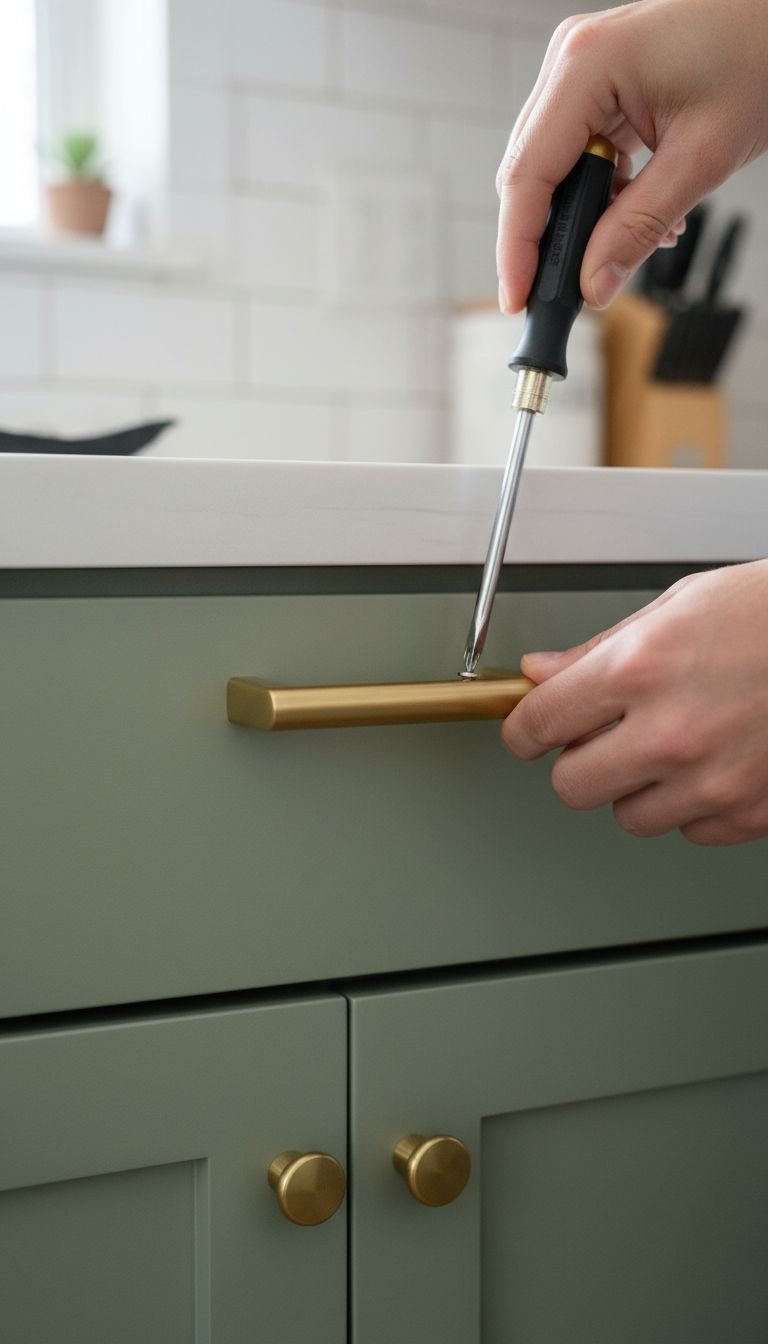
Save this smart storage solution for small spaces!
In a small kitchen, counter space is gold. The best way to clear the clutter is to think vertically. Using a tall, narrow freestanding shelving unit takes advantage of unused wall space, creating a beautiful and functional spot for dishes, pantry staples, and decor without drilling a single hole.
Materials Needed:
- A tall, narrow freestanding shelving unit (like an étagère or ladder shelf) that fits your available wall space
- Optional: Baskets, bins, and clear glass jars for decanting dry goods
- Museum putty for securing decor items
- Anti-tip furniture straps (check your lease if you’re allowed to install these for safety)
Step-by-Step Directions:
- Identify Your Spot: Find an empty sliver of wall in your kitchen or dining nook. Measure the width, depth, and height to ensure your chosen shelf will fit.
- Assemble the Shelf: Build your shelving unit according to the package instructions.
- Zone Your Storage: Dedicate each shelf to a specific purpose. For example, the bottom shelf for heavy items like cookbooks, the middle for everyday dishes, and the top for lighter, decorative items.
- Decant and Organize: Transfer pantry staples like flour, sugar, pasta, and rice into matching clear glass jars. This not only looks beautiful but also lets you see when you’re running low.
- Style Thoughtfully: Mix functional items (stacks of plates) with decorative ones (a small plant or framed art). Use baskets to hide less attractive packaged goods.
Pro-Tip: To create a cohesive look, stick to a limited color palette for your storage containers and dishes. For example, use all white dishes, clear glass jars, and natural woven baskets.
5. Add a Flexible Rolling Kitchen Cart
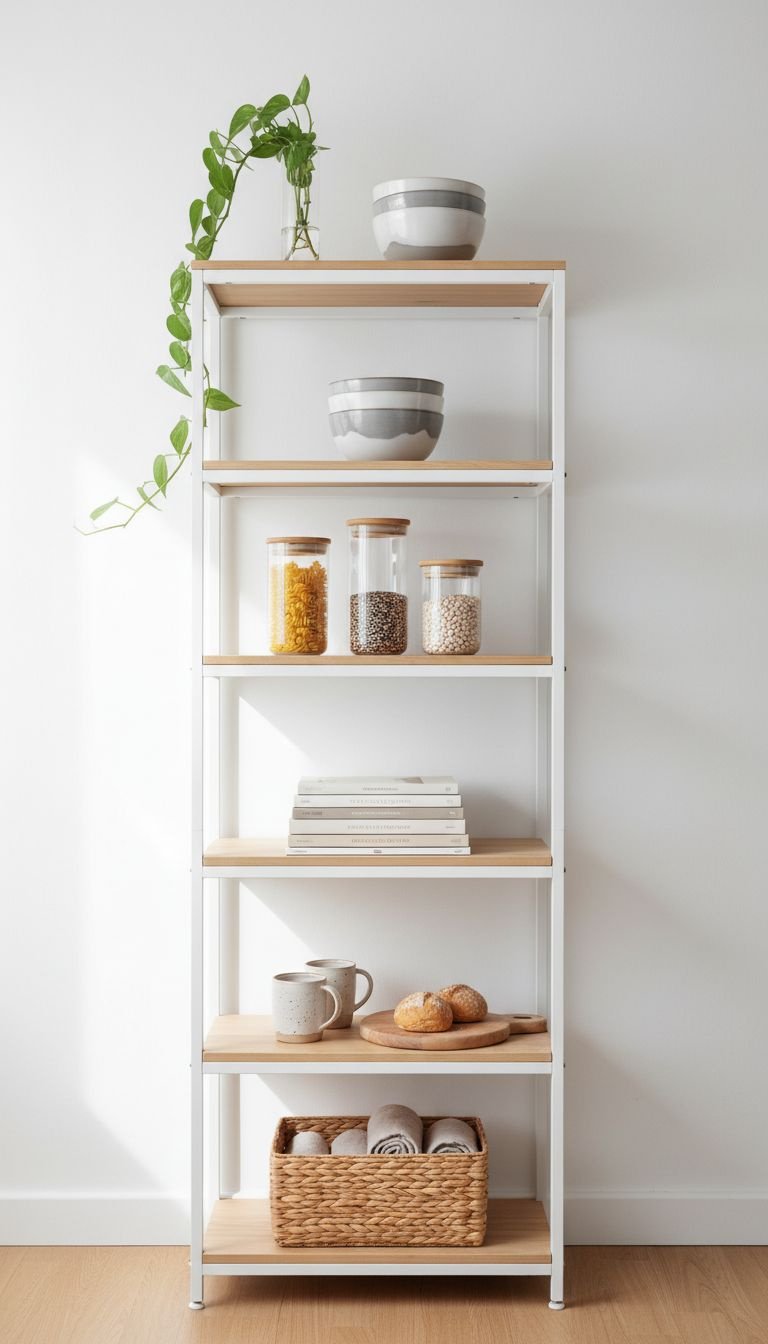
Pin this idea for when you have no counter space!
If your number one complaint is “no counter space,” a rolling kitchen cart is your new best friend. It acts as a portable kitchen island, offering extra surface area for food prep, a home for small appliances like your microwave or air fryer, and additional shelving for pots and produce.
Materials Needed:
- A rolling kitchen cart that fits your kitchen’s dimensions and style (stainless steel, wood top, etc.)
- Optional: S-hooks, baskets, and storage containers for the shelves
Step-by-Step Directions:
- Measure Your Space: Determine the maximum size cart your kitchen can accommodate while still allowing for easy movement. Remember to account for opening appliance doors.
- Choose Your Style: Select a cart that complements your kitchen’s aesthetic. A stainless steel top is great for a modern look, while a butcher block top adds warmth.
- Assemble and Position: Build the cart and find its primary “home.” This might be against a wall or at the end of a counter. Lock the wheels for stability.
- Organize for Function: Use the cart to solve your biggest problem. If you need prep space, keep the top clear. If you need appliance storage, use it to house your microwave or air fryer. Use the shelves for produce, pots, or mixing bowls.
- Utilize the Sides: Hang dish towels, oven mitts, or utensils from the cart’s handle or sidebars using S-hooks to free up even more drawer space.
Lesson Learned: Choose a cart with at least two locking wheels. This is a crucial safety feature that keeps it from rolling away while you’re chopping vegetables or using an appliance on top.
6. Install No-Electrician-Needed Under-Cabinet Lighting
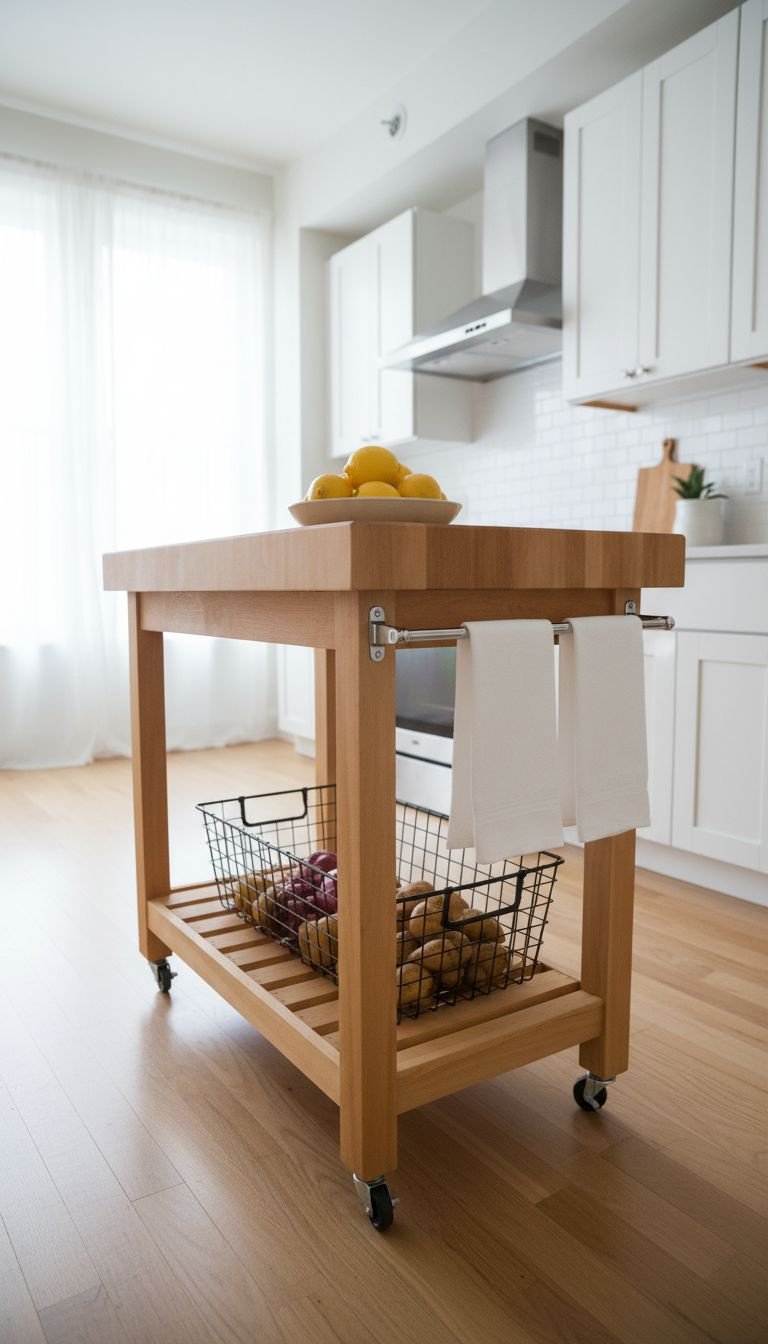
Save this easy lighting tips to brighten your kitchen!
A dark, shadowy kitchen can feel gloomy and make food prep difficult. Under-cabinet lighting is a form of task lighting that instantly makes a kitchen feel more expensive and functional. The best part? You don’t need an electrician. Battery-operated or plug-in LED light strips are incredibly easy to install.
Materials Needed:
- A set of battery-operated, stick-on LED puck lights (many come with a remote control) OR a plug-in LED light strip kit
- Alcohol wipes or cleaner
- Batteries (if using puck lights)
- Small, clear adhesive cord clips (if using a plug-in strip)
Step-by-Step Directions:
- Choose Your Type: Decide between puck lights for focused pools of light or a strip for more even, continuous light. Battery-operated is easiest, while plug-in is brighter and requires no battery changes.
- Prep the Surface: Clean the underside of your cabinets with an alcohol wipe to ensure the adhesive will stick properly.
- Plan Placement: Map out where you’ll place the lights for the most effective illumination of your prep areas. For puck lights, space them about 12-20 inches apart.
- Stick Them On: Peel the backing off the adhesive and press each light firmly in place for about 30 seconds.
- Manage Cords (for Plug-in): If you used a strip, run the cord down the corner where the wall meets the cabinet and use clear adhesive clips to secure it neatly along the backsplash to the outlet.
Pro-Tip: Buy lights that allow you to change the color temperature. A warmer white (around 2700K) is cozy and inviting, while a cooler, brighter white (around 4000K) is better for task-heavy prep work.
7. Hide Ugly Floors with a Stylish Runner
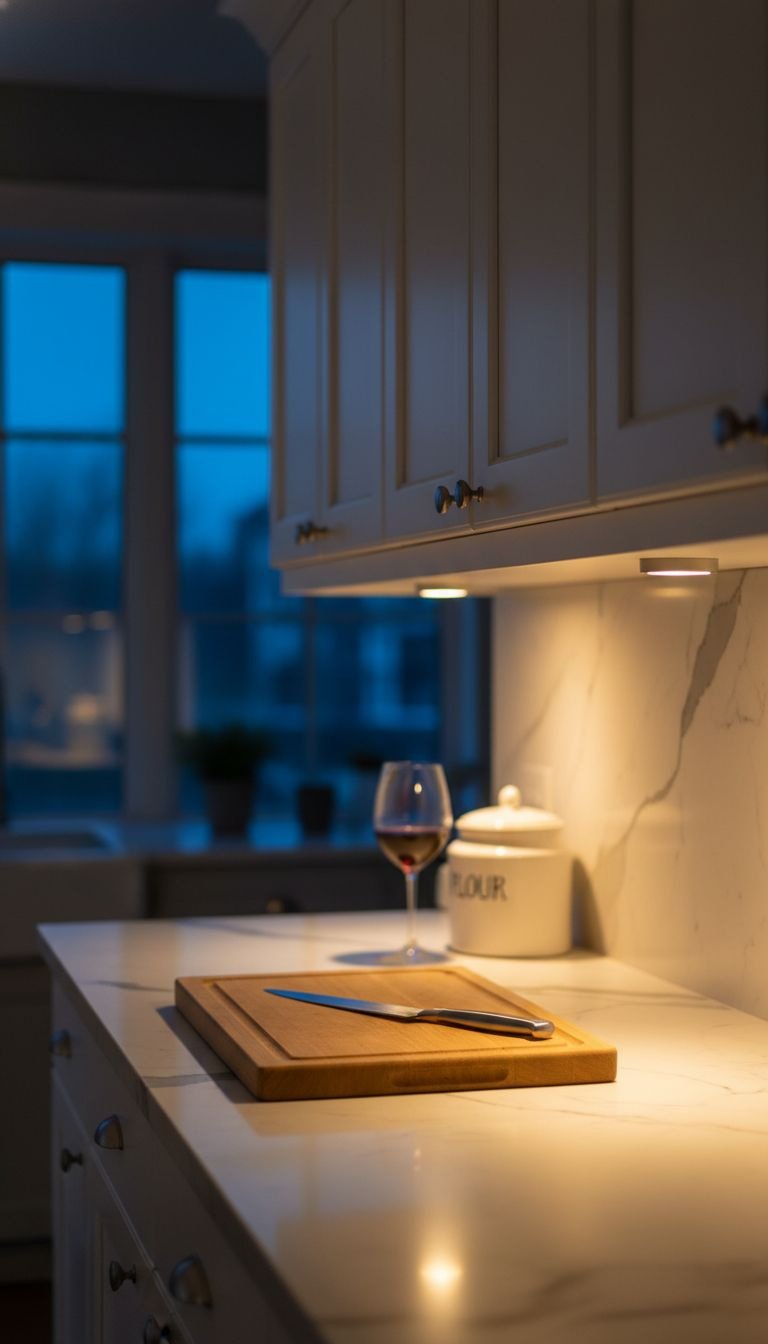
Pin this simple solution for ugly rental floors!
Don’t let dated linoleum or cracked tile bring down the whole vibe of your kitchen. A kitchen runner rug is the perfect renter-friendly flooring solution to hide ugly floors, add a major dose of color and pattern, and make the space more comfortable to stand in.
Materials Needed:
- A washable kitchen runner rug of the appropriate size
- A non-slip rug pad
- Measuring tape
Step-by-Step Directions:
- Measure Your Kitchen: Measure the length and width of the main walkway in your kitchen, usually the space between the two sets of counters in a galley kitchen.
- Select the Right Size: Choose a runner that is long enough to cover the main work area but leaves a few inches of flooring visible on all sides. This makes the space look more intentional.
- Prioritize Washability: Look specifically for rugs labeled as “machine-washable.” Kitchens are high-spill zones, and this feature is a lifesaver.
- Add a Rug Pad: Place a non-slip rug pad underneath the runner. This is a critical step for safety, preventing the rug from sliding on a slick kitchen floor.
- Lay It Down: Unroll your rug pad and runner, and instantly enjoy the added color, pattern, and comfort underfoot.
Pro-Tip: In a small kitchen, a rug with a bold pattern or color can act as the main focal point, drawing the eye away from other less desirable features like dated cabinets or countertops.
8. Use Magnetic Racks for Genius Fridge Storage

Save this amazing space-saving tips for your tiny kitchen!
The side of your refrigerator is one of the most underutilized storage areas in an apartment kitchen. Strong magnetic racks can instantly create off-counter storage for spices, paper towels, oils, and more, solving cluttered kitchen problems in seconds.
Materials Needed:
- A strong magnetic spice rack
- Optional: Magnetic paper towel holder, magnetic knife strip, or magnetic hooks
- Matching glass spice jars (optional, for a cohesive look)
Step-by-Step Directions:
- Assess Your Fridge: Identify the side of your refrigerator that is most accessible and has enough space for a rack. Make sure it won’t obstruct any doorways.
- Choose Your Racks: Purchase magnetic racks designed for this purpose. Ensure they have strong magnets rated to hold the weight of what you plan to store.
- Decant Spices: For the most aesthetic look, transfer your most-used spices into a set of matching jars with nice labels.
- Attach and Arrange: Simply stick the magnetic racks to the side of the fridge. Press firmly. Arrange your spices, paper towels, or other items neatly.
- Free Up Your Counter: Move the items that were previously cluttering your counter onto their new magnetic home.
Pro-Tip: This tips works for more than just spices! Use magnetic hooks to hang oven mitts and measuring spoons, or a magnetic basket to hold tin foil and plastic wrap.
9. Create a Stunning Accent Wall with Removable Wallpaper
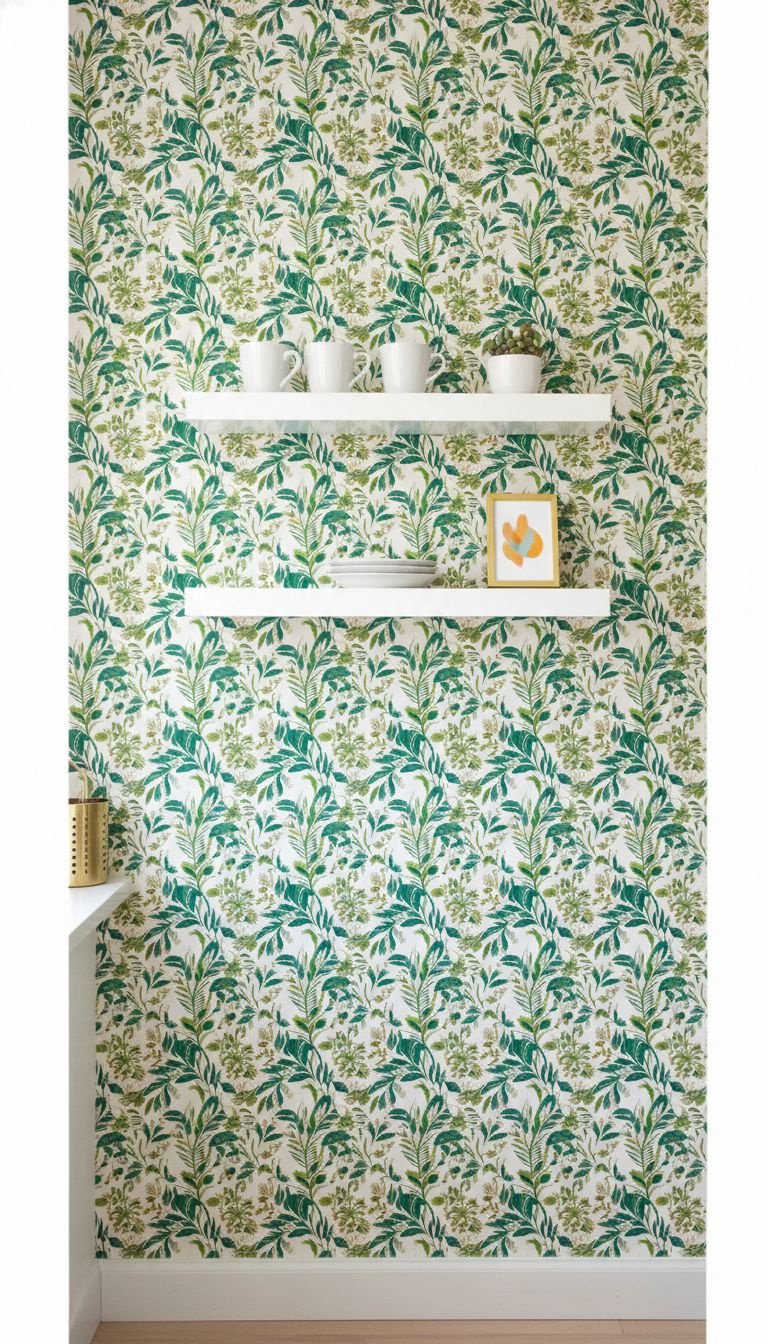
Pin this bold idea to add personality to your kitchen!
If your kitchen walls are feeling boring and you’re not allowed to paint, removable wallpaper is your answer. Creating a single accent wall with a bold botanical or geometric pattern adds a huge dose of personality and creates an immediate focal point.
Materials Needed:
- High-quality peel-and-stick removable wallpaper (measure your wall and order 10-15% extra for matching patterns)
- Smoothing tool or squeegee
- Sharp craft knife or razor blade
- Level and pencil
- Measuring tape
Step-by-Step Directions:
- Pick Your Wall: Choose a small, uninterrupted wall to be your accent wall. A wall without too many windows or doors is easiest for a beginner.
- Prep the Wall: Clean the wall thoroughly to remove any dust or grease and let it dry.
- Draw a Guideline: Use a level to draw a perfectly vertical pencil line from the ceiling to the floor where your first panel will hang. This is the most important step!
- Hang the First Panel: Peel about a foot of backing from your first roll of wallpaper. Align the edge with your pencil line and smooth it onto the wall from the top down.
- Match and Repeat: For the next panel, carefully align the pattern on the wallpaper with the panel you just hung before sticking it to the wall. Overlap the seam slightly if the manufacturer recommends it. Use the smoothing tool to remove bubbles as you go.
- Trim the Edges: Use a straight edge and a sharp craft knife to trim the excess wallpaper at the ceiling and baseboard for a clean finish.
Lesson Learned: Don’t be afraid to peel off and reposition the wallpaper a few times to get the alignment perfect. High-quality removable wallpaper is designed to be forgiving.
Key Takeaways: Your Quick Guide to an Aesthetic Rental Kitchen
- Focus on Surfaces First: The biggest visual changes come from covering dated countertops, backsplashes, and floors with removable products.
- Go Vertical with Storage: Get clutter off your counters by using walls and the side of your fridge for storage.
- Lighting is Everything: Add simple, non-permanent under-cabinet lighting to make your kitchen feel brighter and more expensive.
- Small Details, Big Impact: Never underestimate the power of swapping cabinet hardware or adding a colorful rug.
- Always Save the Originals: To guarantee your security deposit back, keep all original hardware in a labeled bag to reinstall before you move out.
People Also Ask About Aesthetic Apartment Kitchens
How can I cover my ugly kitchen countertops in a rental?
The best renter-friendly solution is to use high-quality, removable vinyl contact paper. Look for products labeled as waterproof and durable. When applied correctly to a clean surface, it can give you the look of marble, butcher block, or soapstone for a fraction of the cost and can be removed with a hairdryer when you move.
What can I do about ugly kitchen cabinets without painting?
Use removable peel-and-stick wallpaper or vinyl film to cover the cabinet doors. This adds color or pattern without any permanent changes. An even easier, high-impact update is to simply swap out the cabinet knobs or pulls, which only requires a screwdriver. Just be sure to store the original hardware safely.
How do I add more storage to a tiny apartment kitchen?
Maximize your vertical space. Use a tall, freestanding shelving unit for pantry items, a rolling kitchen cart for flexible prep space and storage, and magnetic racks on the side of your fridge for spices. Over-the-door organizers and under-shelf baskets are also excellent for maximizing cabinet space.
Is peel and stick backsplash actually removable?
Yes, most quality peel-and-stick tiles are designed to be removable and renter-friendly. However, it’s critical to clean the wall thoroughly before application and to test a piece in a hidden area first. When it’s time to move, warming the tiles with a hairdryer will soften the adhesive, making them easier to peel off without damaging the wall.
Final Thoughts
Your rental kitchen doesn’t have to be a boring, temporary space you just have to put up with. It holds incredible potential to be a room you love. By focusing on smart, renter-friendly solutions that maximize storage, transform surfaces, and add a dose of your personality, you can create a beautiful, functional, and stylish kitchen that truly feels like home. With a little creativity, you can design a space that inspires you every single day.
Which of these aesthetic apartment kitchen ideas are you most excited to try in your own space? Share your plans in the comments below
Last update on 2025-11-29 at 03:19 / Affiliate links / Images from Amazon Product Advertising API
